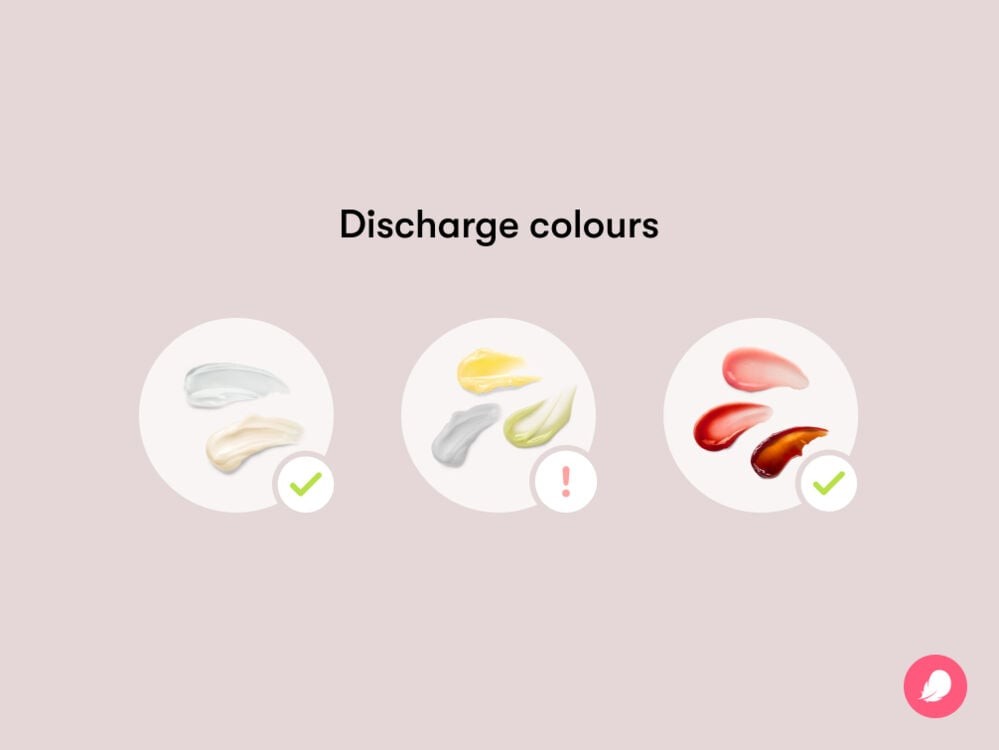Is your vaginal discharge orange? This article, brought to you by WHY.EDU.VN, provides a comprehensive overview of the potential causes of orange vaginal discharge, exploring reasons ranging from normal physiological processes to possible underlying infections. Learn about vaginal health and atypical discharge to address your health concerns. We’ll also delve into spotting between periods, and changes in cervical fluid.
1. What Is Orange Discharge and Is It Normal?
While truly orange discharge is uncommon, what appears orange is often a result of blood mixing with normal vaginal discharge. Dr. Sara Twogood, an obstetrician and gynecologist, explains that the presence of blood can create a light brown hue that is sometimes perceived as orange. This is typically normal if it occurs right before or after your period, or even after ovulation when some individuals experience spotting. If this is not the case for you, you might want to see a doctor.
2. What Causes Blood to Mix With Vaginal Discharge?
Several factors can cause blood to mix with your discharge, leading to an orange or reddish tint. Understanding these can help you determine if your discharge is within the range of normal or if further investigation is needed.
2.1 Menstruation
Discharge can vary slightly before and after your period due to changes in blood flow intensity. Periods typically last two to seven days, with the heaviest flow during the first three days. As your period begins and ends, the flow is lighter, and the mixing of blood with vaginal discharge can cause a pink or brown appearance. This happens because the blood has more time to oxidize and mix with the discharge.
2.2 Ovulation Spotting
Ovulation occurs when an ovary releases an egg. Studies show that approximately 5% of women experience bleeding around ovulation. Hormonal changes, particularly a drop in estrogen levels, can cause the uterine lining to bleed, resulting in light spotting that mixes with discharge. This mix may cause the discharge to appear pink or orange. Ovulation bleeding is not as common, so its absence does not mean you haven’t ovulated.
2.3 Implantation Bleeding
Implantation bleeding occurs in early pregnancy when a fertilized egg attaches to the uterine walls. This process can cause a small amount of bleeding that mixes with vaginal discharge, potentially giving it an orange tint. Not everyone experiences implantation bleeding, and it is usually lighter than menstrual bleeding.
3. Other Factors That Can Change Discharge Color
Besides blood mixing with discharge, other factors such as vaginal and cervical infections can cause irritation, potentially leading to spotting or bleeding that affects the color of your discharge.
3.1 Bacterial Vaginosis (BV)
Bacterial vaginosis is an infection caused by an imbalance of bacteria in the vagina. BV is typically associated with a gray discharge and a strong, fishy odor. While BV often presents with gray discharge, irritation can sometimes cause slight bleeding, leading to a change in color.
3.2 Sexually Transmitted Infections (STIs)
Changes in discharge color, texture, or smell can indicate an STI. Some STIs associated with changes in discharge include:
- Chlamydia: Can cause yellow or cloudy discharge.
- Gonorrhea: Can cause increased discharge that may be yellow, green, or cloudy.
- Trichomoniasis: Can cause frothy, yellow-green discharge with a foul odor.
If you notice unusual changes, especially with other uncomfortable symptoms, consulting a doctor is essential to rule out and treat potential infections.
4. What Does Normal Vaginal Discharge Look Like?
Normal vaginal discharge is usually clear or whitish, with a mild odor. The consistency can vary from wet and slippery to sticky and gooey, or thick and creamy to drier and more pasty. Typically, the amount of discharge is around 0.5 to 1 teaspoon (2.5 to 5 ml) daily.
Dr. Twogood emphasizes that “normal” discharge varies significantly among individuals. Changes in hormones throughout the menstrual cycle can affect discharge, with different types observed at various times:
- After your period: A white, creamy discharge is common.
- Right before ovulation: A clear, slippery discharge resembling raw egg whites.
- After ovulation: A drier discharge.
Keeping track of your baseline can help you detect red flags or unusual changes.
5. When To Be Concerned About Orange Discharge
If you notice an orange tint and it’s around your period, it’s likely part of your normal pattern. However, if the orange discharge is unusual for you or accompanied by other symptoms like pain, irritation, or inflammation, you should consult a healthcare professional. Changes in discharge can be a sign of underlying conditions needing treatment.
6. Vaginal Discharge Color Chart
Understanding the color of your discharge can help you identify potential health concerns. Here is a quick guide to various discharge colors and their possible causes:
| Color | Possible Causes | What to Do |
|---|---|---|
| Clear | Normal; may indicate ovulation | No action needed |
| White | Normal; can vary in consistency throughout the cycle | No action needed unless accompanied by itching or odor |
| Yellow | Possible infection; may indicate an STI | Consult a healthcare provider |
| Green | Infection; often indicates trichomoniasis or another STI | Consult a healthcare provider |
| Gray | Bacterial vaginosis (BV) | Consult a healthcare provider |
| Pink | Light bleeding; may occur during ovulation or early pregnancy (implantation) | Monitor; consult a healthcare provider if it persists or if you suspect pregnancy |
| Red | Menstruation; possible infection or other issues if not related to your period | Monitor; consult a healthcare provider if it’s not related to your period or if you experience other symptoms |
| Brown | Old blood; can occur at the end of your period or due to other factors | Monitor; consult a healthcare provider if it’s persistent or accompanied by other symptoms |
| Orange | Often a mix of blood and discharge; can be normal around menstruation or ovulation, but could indicate an infection | Monitor; consult a healthcare provider if it’s unusual for you, or if accompanied by other symptoms such as pain, itching, or foul smell |



7. The Role of Vaginal Discharge
Vaginal discharge has significant functions that keep the vagina clean, healthy, and lubricated. The vaginal discharge is a part of the natural processes for fighting off infections and bacteria. Moreover, changes in discharge may show what is going on inside the body.
8. Seeking Medical Advice for Unusual Discharge
When in doubt, it is always best to seek professional medical advice to address any concerns regarding changes in vaginal discharge. Healthcare providers can diagnose underlying conditions and provide treatment.
9. Frequently Asked Questions About Orange Discharge
9.1 What does rust-colored discharge mean?
Rust-colored discharge often indicates that a bit of blood has mixed with your vaginal discharge. In many cases, this is not a cause for concern. However, if you are not near your period and especially if the discharge has a foul odor or you’re experiencing other uncomfortable vaginal symptoms, it could signal an infection. In such cases, you should consult your doctor.
9.2 Can implantation cause orange discharge?
During early pregnancy, when a fertilized egg attaches to the uterine wall, a small amount of bleeding may occur. This blood can mix with vaginal discharge, leading to a change in color. While implantation is a possible cause of orange discharge, it’s not the only one.
9.3 What colors are unhealthy for discharge?
Typically, yellow, green, and gray are considered unhealthy colors for vaginal discharge, often suggesting an underlying infection. However, orange, brown, and red discharges can also indicate a problem, particularly if you are not near your period.
10. Additional Tips for Vaginal Health
Here are some additional recommendations to maintain vaginal health:
- Practice good hygiene by washing the external genital area with mild soap and water.
- Avoid douching, as it can disrupt the natural balance of bacteria in the vagina.
- Wear cotton underwear to promote breathability and reduce moisture.
- Change out of wet clothes, such as swimsuits or workout gear, as soon as possible to prevent bacterial or yeast growth.
11. Addressing Concerns and Seeking Expert Advice with WHY.EDU.VN
Navigating the nuances of vaginal health can be challenging, especially when unexpected changes like orange discharge occur. While this article provides valuable insights, remember that every individual is unique, and consulting a healthcare professional is essential for personalized guidance.
At WHY.EDU.VN, we understand the importance of accessible and reliable health information. We strive to provide comprehensive answers to your health questions and connect you with experts who can offer tailored advice.
11.1 Personalized Answers and Expert Advice
WHY.EDU.VN bridges the gap between general health information and expert guidance. Our platform offers a space for you to ask specific questions and receive personalized answers from professionals. This ensures that you receive advice tailored to your individual circumstances, helping you make informed decisions about your health.
11.2 Trustworthy and Reliable Information
We understand the overwhelming amount of information available online and the difficulty in discerning reliable sources. WHY.EDU.VN is committed to providing accurate, trustworthy, and up-to-date health information. Our content is carefully reviewed by experts to ensure it meets the highest standards of quality and reliability.
11.3 A Supportive Community
Beyond providing answers, WHY.EDU.VN fosters a supportive community where you can connect with others who share similar concerns. This community provides a safe and inclusive space to share experiences, ask questions, and find encouragement.
11.4 Easy Access to Information
Finding the right information should be straightforward and stress-free. Our platform is designed to provide easy access to expert answers, reliable resources, and a supportive community, empowering you to take control of your health journey.
If you have specific concerns about orange discharge or other health issues, WHY.EDU.VN encourages you to reach out to our experts. Our team is dedicated to providing you with the knowledge and support you need to navigate your health with confidence.
Remember, your health is a priority. Let WHY.EDU.VN be your trusted partner in finding accurate answers and expert advice, ensuring you are well-informed and empowered to make the best decisions for your well-being.
12. Empowering Your Health Journey
Understanding changes in your body, like the color of your vaginal discharge, is a key step in maintaining your health. Whether it’s orange, brown, or another color, knowing what’s normal and what’s not can help you take timely action.
Orange discharge can be a normal variation related to your menstrual cycle or ovulation. However, it can also signal an infection or other underlying condition. Paying attention to other symptoms, such as odor, itching, or pain, can provide valuable clues.
If you’re unsure about the cause of your orange discharge or concerned about other changes, don’t hesitate to seek guidance from a healthcare professional. Early diagnosis and treatment can prevent complications and ensure your well-being.
At WHY.EDU.VN, we’re dedicated to providing you with the information and resources you need to navigate your health journey. We encourage you to explore our website, ask questions, and connect with our community of experts. Together, we can empower you to make informed decisions and prioritize your health.
Contact us for further assistance:
- Address: 101 Curiosity Lane, Answer Town, CA 90210, United States
- WhatsApp: +1 (213) 555-0101
- Website: WHY.EDU.VN
Take charge of your health today and discover the answers you seek at why.edu.vn.
13. Related Articles
Explore these related articles for more insights into women’s health:
- Understanding Period Blood Color
- Causes of Brown Vaginal Discharge
- Managing PMS and PMDD
- Pregnancy and Periods: What You Need to Know
14. FAQ about Vaginal Discharge
Here are some frequently asked questions related to vaginal discharge:
-
What is considered a normal amount of vaginal discharge?
A normal amount varies but is typically about 0.5 to 1 teaspoon daily. -
Is it normal for vaginal discharge to change throughout my cycle?
Yes, hormonal fluctuations cause changes in color, consistency, and amount. -
What does it mean if my discharge has a strong odor?
A strong odor can indicate an infection like bacterial vaginosis or trichomoniasis. -
Can douching help maintain vaginal health?
No, douching can disrupt the natural balance of bacteria and is not recommended. -
What should I do if I experience itching or irritation with my discharge?
Consult a healthcare provider as these symptoms often indicate an infection. -
Can certain foods or supplements affect vaginal discharge?
Some anecdotal evidence suggests that probiotics may help maintain vaginal health. -
Is it possible to have a yeast infection without itching?
While itching is a common symptom, it’s possible to have a yeast infection without it. -
How often should I see a doctor for vaginal health checkups?
Regular checkups are important, especially if you experience any unusual symptoms. -
Can stress affect vaginal discharge?
Stress can impact hormone levels, potentially affecting vaginal discharge. -
What are some ways to prevent vaginal infections?
Practice good hygiene, wear cotton underwear, and avoid douching.
15. User Search Intent
Here are 5 possible user search intentions for the keyword “Why Is My Discharge Orange”:
- Information: Seeking general information about the causes and implications of orange vaginal discharge.
- Diagnosis: Trying to self-diagnose the reason for their orange discharge and whether it’s normal.
- Treatment: Looking for potential treatments or remedies for orange discharge, particularly if they suspect an infection.
- Reassurance: Seeking reassurance that their orange discharge is not a sign of a serious medical condition.
- Prevention: Wanting to learn how to prevent orange discharge and maintain overall vaginal health.
